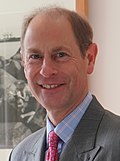| Viscount Severn | |
|---|---|
 | |
| Creation date | 19 June 1999 [1] |
| Creation | First |
| Created by | Elizabeth II |
| Peerage | Peerage of the United Kingdom |
| Present holder | Prince Edward, Duke of Edinburgh |
| Heir apparent | James, Earl of Wessex |
| Remainder to | the 1st Viscount's heirs male of the body lawfully begotten. |
| Status | Extant |
| Seat(s) | Bagshot Park |
Viscount Severn is a title in the Peerage of the United Kingdom. The name of the viscountcy is derived from the River Severn that runs through England and Wales. The title, along with the Earldom of Wessex, was bestowed on Prince Edward by his mother, Queen Elizabeth II, upon his marriage to Sophie Rhys-Jones. [2] Between 1999 and 2023, the title was a subsidiary title of the Earldom of Wessex and Earldom of Forfar. Since 2023, the title is a subsidiary title of the Dukedom of Edinburgh upon the granting of the dukedom to Prince Edward.
